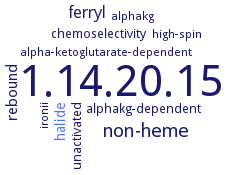1.14.20.15: L-threonyl-[L-threonyl-carrier protein] 4-chlorinase
This is an abbreviated version!
For detailed information about L-threonyl-[L-threonyl-carrier protein] 4-chlorinase, go to the full flat file.

Word Map on EC 1.14.20.15 
-
1.14.20.15
-
non-heme
-
ferryl
-
rebound
-
halide
-
alphakg-dependent
-
unactivated
-
chemoselectivity
-
alphakg
-
ironii
-
high-spin
-
alpha-ketoglutarate-dependent
- 1.14.20.15
-
non-heme
-
ferryl
-
rebound
- halide
-
alphakg-dependent
-
unactivated
-
chemoselectivity
-
alphakg
-
ironii
-
high-spin
-
alpha-ketoglutarate-dependent
Reaction
Synonyms
aliphatic halogenase, SyrB2, syringomycin biosynthesis enzyme 2, Thr3
ECTree
Advanced search results
Metals Ions
Metals Ions on EC 1.14.20.15 - L-threonyl-[L-threonyl-carrier protein] 4-chlorinase
Please wait a moment until all data is loaded. This message will disappear when all data is loaded.
Fe2+
Iron
the enzyme employs an Fe(IV)-oxo species to achieve selective C-H halogenation of L-threonine. Combined quantum mechanical/molecular mechanical (QM/MM) calculations show the presence of three Cl-Fe(IV)-oxo isomers which interconvert. The one having its oxo ligand pointing toward the target C-H bond is active during the hydrogen atom abstraction (H-abstraction) process. The fate of the formed Cl-FeIII-OH/R radical intermediate is determined by a hydrogenbonding interaction between the Arg254 residue and the OH ligand of Cl-Fe(III)-OH
Fe2+
non-haem Fe(II)-dependent enzyme, mononuclear iron enzyme. Crystallographic data confirm that halide ions bind directly to iron, before decarboxylation of 2-oxoglutarate and formation of a reactive ferryl-oxo species
Fe2+
the chloroferryl intermediate state of the enzyme presents opportunities for structural characterization


 results (
results ( results (
results ( top
top






